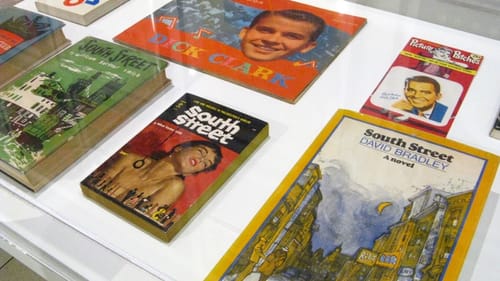Stay in the Loop
BSR publishes on a weekly schedule, with an email newsletter every Wednesday and Thursday morning. There’s no paywall, and subscribing is always free.
Philadelphia’s mid-century renaissance
UArts presents Invisible City: Philadelphia and the Vernacular Avant-garde

Were you here for the renaissance? You were if you lived in Philadelphia between 1956 and 1976. In those years, the city was the art studio of the world, sparking imagination and innovation that ignited postmodern culture. That’s the premise of Invisible City: Philadelphia and the Vernacular Avant-garde, a sprawling exhibition organized by the University of the Arts.
Invisible City examines Philadelphia’s contribution to mid-20th-century music, dance, visual and performance art, literature, city planning, and architectural design. The result of six years of research, it rambles over four physical locations, a digital archive, and a slate of upcoming events.
Flamingos to furniture
From the Pink Flamingos' 1974 birthday party at the TLA to Wharton Esherick’s elegantly limber music stand, crafted in 1962, Invisible City recalls culture low and high, and events small and large, in almost every imaginable art form.
The exhibition celebrates creators and the places in which their work flourished. From Society Hill Playhouse (1960), to American Poetry Review (1972), to Temple Cinematheque (1974), and Philadelphia Anti-Graffiti Network (1974), the precursor of today’s Mural Arts, it demonstrates how an environment can nurture creativity.
Whether you prefer sculpture to sketches, rock to jazz, or memorabilia over blueprints, there’s plenty to see. Reaching it all, however, requires traversing downtown: the show is located in three sites affiliated with UArts—Gershman Hall, Rosenwald-Wolf Gallery, and Philadelphia Art Alliance—as well as the Pennsylvania Academy of the Fine Arts.
Go to Gershman Hall for period posters, books, and ephemera; Rosenwald-Wolf Gallery for painting, sculpture, and conceptual art; and the Art Alliance to see painting, prints, photography, crafts, and architectural materials. PAFA presents works by notable women artists of the period.

Virtual visitors welcome
An extensive digital archive supplements the physical installations, enabling anyone anywhere to concentrate on a particular interest or just wander, exploring and remembering. The archive’s principal feature, a virtual timeline, extends from December 1950, when the Philadelphia Museum of Art acquired the Arensburg collection, to the 1977 formation of Relâche.
Along the way, visitors discover when the Stroll emerged as a dance craze and John Coltrane recorded Blue Train (both 1957). You can drop into 1974 and trace the origin of the Clay Studio and JC Dobbs Club. Or pause in 1968 to recall the first concert at the Electric Factory. The longer your memory, the more fun you’ll find.
Curious as to when Claes Oldenburg’s giant Clothespin or Robert Indiana’s LOVE sculpture was installed? Or when Buckminster Fuller sang on the Penn campus? All 1976. How about when the Schuylkill Expressway opened fully for the first (and possibly last) time? That’s 1958.
According to Sid Sachs, the director of exhibitions at UArts, who initiated the project and curated Invisible City with the assistance of Jennie Hirsh of Maryland Institute College of Art, this is the largest exhibition of its kind here since 1976, when the Philadelphia Museum of Art presented Three Centuries of American Art.
Coming soon: A re-happening
In March, a two-day symposium in Gershman Hall will feature Alex Da Corte reinventing Allan Kaprow’s Chicken, an example of the seminal performance artist's works: in-the-moment improvisations he termed "happenings" that gave art free range in everyday life. Kaprow first performed the work in Gershman Hall in 1962.

An original poster for Chicken is on view in the Gershman lobby, along with others publicizing performances of Modern Jazz Quartet and the Music of Kurt Weill. Cases in the lobby display artifacts on paper, including three novels named for South Street, a bicentennial handbook bearing the once-familiar red, white, and blue Liberty Bell logo, and a magazine article describing the exploits of historically minded artist Bill Beckley, who:
“In 1969…executed a series of five pieces inspired by George Washington…he walked through the Delaware River from west to east at Washington’s crossing, spilling a trail of white latex paint… slept at the George Washington Motor Lodge on the Pennsylvania Turnpike… chopped down a cherry tree… dressed himself like the Gilbert Stuart portrait of Washington [and] signed his name in the manner of George Washington."
You don’t have to have been here…but it helps
While rich in artifacts, installations provide detail only on who, what, where, and when, but not why and how it happened here over those 20 years. The online chronology invites input and will likely expand. Presentations and public discussions during the run of Invisible City, including the symposium, will no doubt provide insight, as will a forthcoming catalog.
Invisible City sheds light on a culturally significant, although recent enough to be familiar (and therefore perhaps unappreciated) era. It organizes voluminous information and raises questions. Its greatest achievement is in calling attention to how special those years were in Philadelphia and in inspiring the desire to know more.
What, When, Where
Invisible City: Philadelphia and the Vernacular Avant-garde runs through April 4, 2020, at four Philadelphia locations: UArts’s Gershman Hall Lobby (401 S. Broad St.); the Philadelphia Art Alliance, (251 S. 18th St.); Rosenwald-Wolf Gallery (333. S 18th St.); and the Pennsylvania Academy of Fine Arts Landmark Building (118-128 N. Broad St.). uarts.edu/invisiblecity
For accessibility information on Gershman Hall, Rosenwald-Wolf Gallery, or Philadelphia Art Alliance, contact University of the Arts: (215) 545-4302 or (215) 717-6480. For information on PAFA, call (215) 972-7600.
Sign up for our newsletter
All of the week's new articles, all in one place. Sign up for the free weekly BSR newsletters, and don't miss a conversation.
